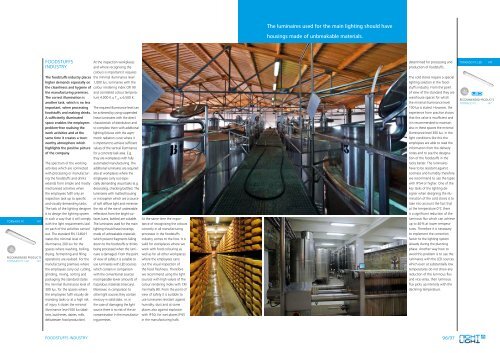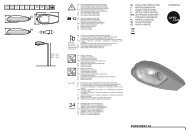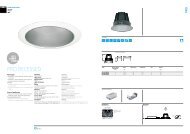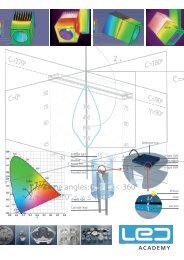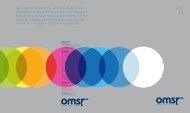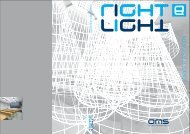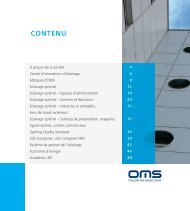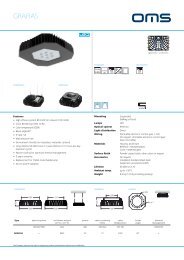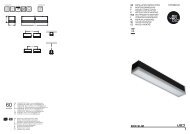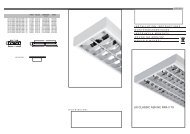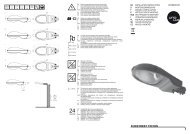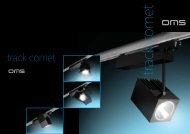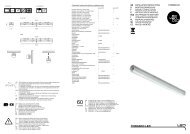Download PDF Catalogue - OMS lighting
Download PDF Catalogue - OMS lighting
Download PDF Catalogue - OMS lighting
You also want an ePaper? Increase the reach of your titles
YUMPU automatically turns print PDFs into web optimized ePapers that Google loves.
The luminaires used for the main <strong>lighting</strong> should have<br />
housings made of unbreakable materials.<br />
TORNADO PC 147<br />
RECOMMENDED PRODUCTS<br />
tornado PC LED 147<br />
FOODSTUFFS<br />
INDUSTRY<br />
The foodstuffs industry places<br />
higher demands especially on<br />
the cleanliness and hygiene of<br />
the manufacturing premises.<br />
The correct illumination is<br />
another task, which is no less<br />
important, when processing<br />
foodstuffs and making drinks.<br />
A sufficiently illuminated<br />
space enables the employees<br />
problem-free realising the<br />
work activities and at the<br />
same time it creates a trustworthy<br />
atmosphere which<br />
highlights the positive picture<br />
of the company.<br />
The spectrum of the working<br />
activities which are connected<br />
with processing or manufacturing<br />
the foodstuffs and drinks<br />
extends from simple and mostly<br />
mechanised activities when<br />
the employees fulfil only an<br />
inspection task up to specific<br />
and visually demanding tasks.<br />
The task of the <strong>lighting</strong> designer<br />
is to design the <strong>lighting</strong> system<br />
in such a way that it will comply<br />
with the light requirements laid<br />
on each of the activities carried<br />
out. The standard EN 12464-1<br />
states the minimal level of<br />
illuminance 200 lux for the<br />
spaces where washing, boiling,<br />
drying, fermenting and filling<br />
operations are realised. For the<br />
manufacturing premises where<br />
the employees carry out cutting,<br />
grinding, mixing, sorting and<br />
packaging the standard states<br />
the minimal illuminance level of<br />
300 lux, for the spaces where<br />
the employees fulfil visually demanding<br />
tasks or at a high risk<br />
of injury it states the minimal<br />
illuminance level 500 lux (abattoirs,<br />
butcheries, dairies, mills,<br />
delicatessen food production).<br />
At the inspection workplaces<br />
and where recognising the<br />
colours is important it requires<br />
the minimal illuminance level<br />
1,000 lux, luminaires with the<br />
colour rendering index CRI 90<br />
and correlated colour temperature<br />
4,000 K ≤ T CP<br />
≤ 6,500 K.<br />
The required illuminance level can<br />
be achieved by using suspended<br />
linear luminaires with the direct<br />
characteristic of distribution and<br />
to complete them with additional<br />
<strong>lighting</strong> fixtures with the asymmetric<br />
radiation curve where it<br />
is important to achieve sufficient<br />
values of the vertical illuminance<br />
for a concrete task area. E.g.<br />
they are workplaces with fully<br />
automated manufacturing. The<br />
additional luminaires are required<br />
also at workplaces where the<br />
employees carry out especially<br />
demanding visual tasks (e.g.<br />
decorating, checking bottles). The<br />
luminaires with matted housing<br />
or microprism which are a source<br />
of soft diffuse light and minimise<br />
the risk of the rise of undesirable<br />
reflections from the bright surfaces<br />
(cans, bottles) are suitable.<br />
The luminaires used for the main<br />
<strong>lighting</strong> should have housings<br />
made of unbreakable materials<br />
which prevent fragments falling<br />
down to the foodstuffs or drinks<br />
being processed when the luminaire<br />
is damaged. From the point<br />
of view of safety it is suitable to<br />
use luminaires with LED sources<br />
which contain in comparison<br />
with the conventional sources<br />
incomparable lower amounts of<br />
hazardous materials (mercury).<br />
Moreover, in comparison to<br />
other light sources they contain<br />
mercury in solid state, i.e. in<br />
the case of damaging the light<br />
source there is no risk of the air<br />
contamination in the manufacturing<br />
premises.<br />
At the same time the importance<br />
of recognising the colours<br />
correctly in all manufacturing<br />
processes in the foodstuffs<br />
industry comes to the fore. It is<br />
valid for workplaces where we<br />
work with food colouring as<br />
well as for all other workplaces<br />
where the employees carry<br />
out the visual inspection of<br />
the food freshness. Therefore<br />
we recommend using the light<br />
sources with high values of the<br />
colour rendering index with CRI<br />
minimally 80. From the point of<br />
view of safety it is suitable to<br />
use luminaires resistant against<br />
humidity, dust and at some<br />
places also against explosion<br />
with IP 50, for wet places IP 65<br />
in the manufacturing halls<br />
determined for processing and<br />
production of foodstuffs.<br />
The cold stores require a special<br />
<strong>lighting</strong> solution in the foodstuffs<br />
industry. From the point<br />
of view of the standard they are<br />
warehouse spaces for which<br />
the minimal illuminance level<br />
100 lux is stated. However, the<br />
experience from practice shows<br />
that this value is insufficient and<br />
it is recommended to maintain<br />
also in these spaces the minimal<br />
illuminance level 300 lux. In the<br />
light conditions like this the<br />
employees are able to read the<br />
information from the delivery<br />
notes and to see the designation<br />
of the foodstuffs in the<br />
racks better. The luminaires<br />
have to be resistant against<br />
coolness and humidity therefore<br />
we recommend to use the types<br />
with IP 54 or higher. One of the<br />
key tasks of the <strong>lighting</strong> designer<br />
when designing the illumination<br />
of the cold stores is to<br />
take into account the fact that<br />
at the temperature 0°C there<br />
is a significant reduction of the<br />
luminous flux which can achieve<br />
up to 40 % at lower temperatures.<br />
Therefore it is necessary<br />
to implement the correction<br />
factor to the <strong>lighting</strong> system<br />
already during the planning<br />
phase. Another way how to<br />
avoid this problem is to use the<br />
luminaires with the LED sources<br />
which even at substantially low<br />
temperatures do not show any<br />
reduction of the luminous flux<br />
and vice versa, their luminous<br />
flux picks up intensity with the<br />
declining temperature.<br />
TORNADO PC led 147<br />
RECOMMENDED PRODUCTS<br />
tornado PC 147<br />
foodstuffs INDUSTRY<br />
96/97


